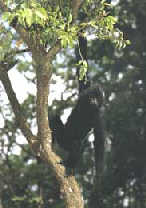Also known as Black Gibbon, it belongs to the Pongidae family of Primates order, with the scientific name of Hylobates concolor (Latin), or Crested Gibbon or Black Gibbon (English).
 Its body length is 43 to 54 centimeters, with the forelimbs longer than the posterior limbs. The male is black all over, with vertices hair on the head that is similar to black crown in shape. The adult female is gray, brown and yellow, with black vertices. Young ape is black regardless of sex. Both the male and female are tailless, without cheek pouch.
Its body length is 43 to 54 centimeters, with the forelimbs longer than the posterior limbs. The male is black all over, with vertices hair on the head that is similar to black crown in shape. The adult female is gray, brown and yellow, with black vertices. Young ape is black regardless of sex. Both the male and female are tailless, without cheek pouch.
It inhabits in tropical rain forests or wildwood at an elevation of 2,000 meters. It leads a kin-type life, in groups with 3 to 5 or 7 to 8 family members in general. It is alert in nature, moving about in the morning and dusk, with fixed territory and routes of activities. It dwells on trees freely and seldom gets down to the ground. When sleeping, it curls on trees, sometimes rests on its back on big trees. It mainly feeds on burgeons and fruits, as well as insects and bird ova. It seldom gets down to the ground to drink water, and mainly depends on dew on leaves. The gestation period of female lasts over 6 months. It has one fetus annually and one baby per fetus. The male grows to sexual maturity at the age of 9, and its lifespan can reach over 30 years. Like other animals of Hylobates genus, Black Gibbon is an important research subject for Primates experts and psychologist.
Annals show its distribution in Guangxi Zhuang Autonomous Region, even as far as the Three Gorges of the Yangtze River. Now it only scatters in Yunnan Province and Hainan Island, with a small quantity of 400 to 500 heads. Being on the edge of extinction, it is in need of urgent protection.
Black Gibbon has been listed in Appendix I ofInternational Trade Convention on Endangered Wild Animal and Plant Species.
